Add a Machining Process to a Catalog
You can add a Machining Process to a catalog.
Select - Click Next then Finish.
A new catalog is created.
- In the Catalog Editor that opens, right-click the catalog you have created and select .
- Click Finish.
Select . - Click
 in the top left toolbar to open the Machining Process View. in the top left toolbar to open the Machining Process View.
- Click
 to search and open a Machining Process. to search and open a Machining Process.
In the Catalog Editor, right-click the chapter and select in the contextual
menu.
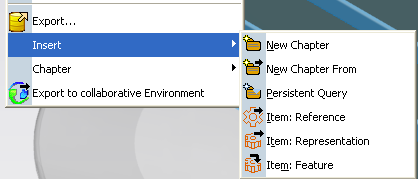
In the Machine Programming window, select the Machining Process in the Machining Process View. The Machining Process is added to the catalog.


Add a Machining Process to Catalog Using Send to Catalog Command
You can add a Machining Process in a PLM catalog by creating a new PLM catalog or updating an existing one. You can also create a new chapter and insert a Machining Process as an item in the chapter, with a keyword displaying the name of parent product where it is stored.
Go to Machining
Process View
 and create a new Machining Process with a Machining Operation. and create a new Machining Process with a Machining Operation. See Create a Machining Process Click to save Machining Process with a Machining Operation in the database. An error message appears if Machining Process is not saved in the database. Right-click a Machining Process and select Send to Catalog command in the contextual menu.
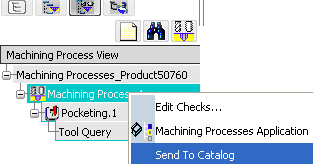
The Send to catalog dialog box appears.

To create a new catalog: - Select Create a new catalog check box to create a new catalog.
The Catalog dialog box appears.
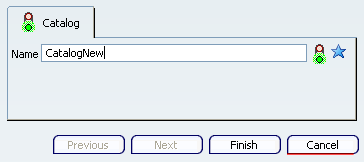
- Specify the catalog name.
- Click Finish to create a new catalog.
A message informs that a new catalog is successfully created. The created catalog appears in Catalog name drop-down list.
To create a new chapter: - Select Chapter check box.
- Select New chapter in Chapter drop-down list and click OK.

The Chapter dialog box appears.
- Specify Chapter name and click Finish to create a new chapter.
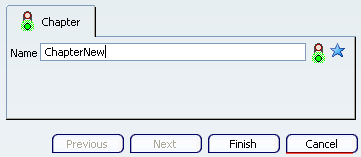
A message informs that a new chapter is successfully created. The created chapter appears in Chapter name drop-down list.
To update an existing catalog: - Select the Catalog name from the drop-down list or from database
 . .
- Select Chapter check box and select existing chapter from the drop-down list to add the Machining Process to the selected chapter.
A warning message appears if a Machining Process is already attached to the chapter of the selected catalog. Note:
If you attach a Machining Process to a catalog that already contains a Machining Process with similar name, then catalog refers both Machining Process.

Select . Select CatalogNew/ChapterNew and instantiate the Machining Process. See Apply a Machining Process from a Catalog
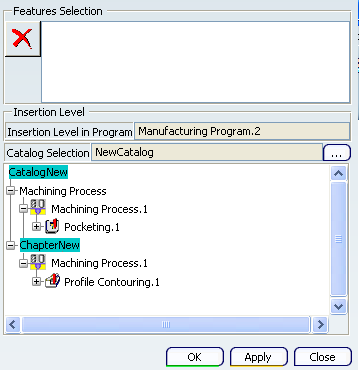

Instantiate a Machining Process from an Open Catalog
You can load a catalog in your session and instantiate a Machining Process from the Catalog Editor.
Open the catalog containing the Machining Process you want to instantiate. - Right-click the Machining Process and select in the contextual menu.
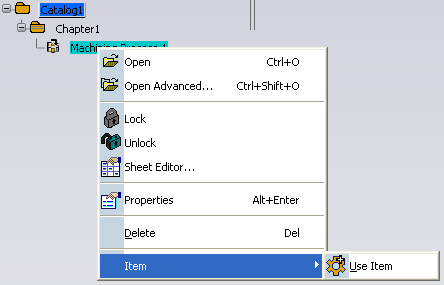
In the Machine Programming window, select an activity in the Activities Process Tree as the insertion level. A Machining Process Application Manager opens. The Machining Process is displayed in the lower part.
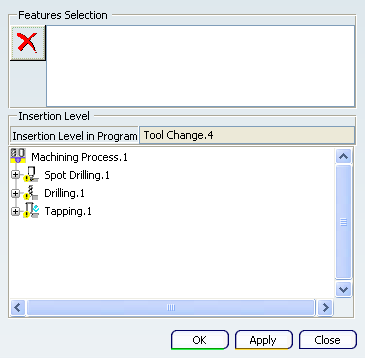
Select the features to be affected to the
activities of the Machining Process and modify the Insertion level if
necessary. - Click Features Selection and select features from the Manufacturing View
- Click Insertion Level in Program and select another activity to modify the insertion level.
Click OK or Apply to apply the Machining Process. See Creating Machining Processes with Knowledge.

Apply a Machining Process from a Catalog
You can apply a Machining Process directly from a catalog. Neither the catalog nor the Machining Process View are open.
In a Machine Programming window, select . A Machining Process Application Manageropens.
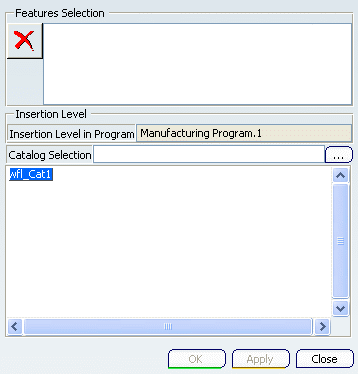
Click {...} and search a catalog from the database. The catalog and the Machining Processes it contains are displayed in the lower part of the dialog box.
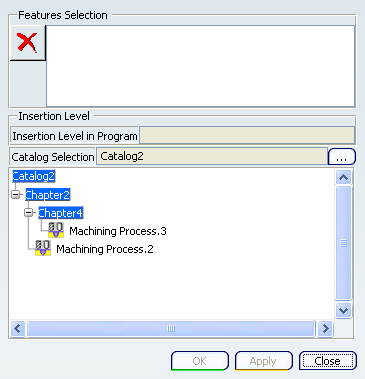
Select the chapter you need. All the Machining
Processes in the chapter are selected for the instantiation.
You can also select the catalog to instantiate all the Machining
Processes
of the catalog. Click OK.
|
![]()












